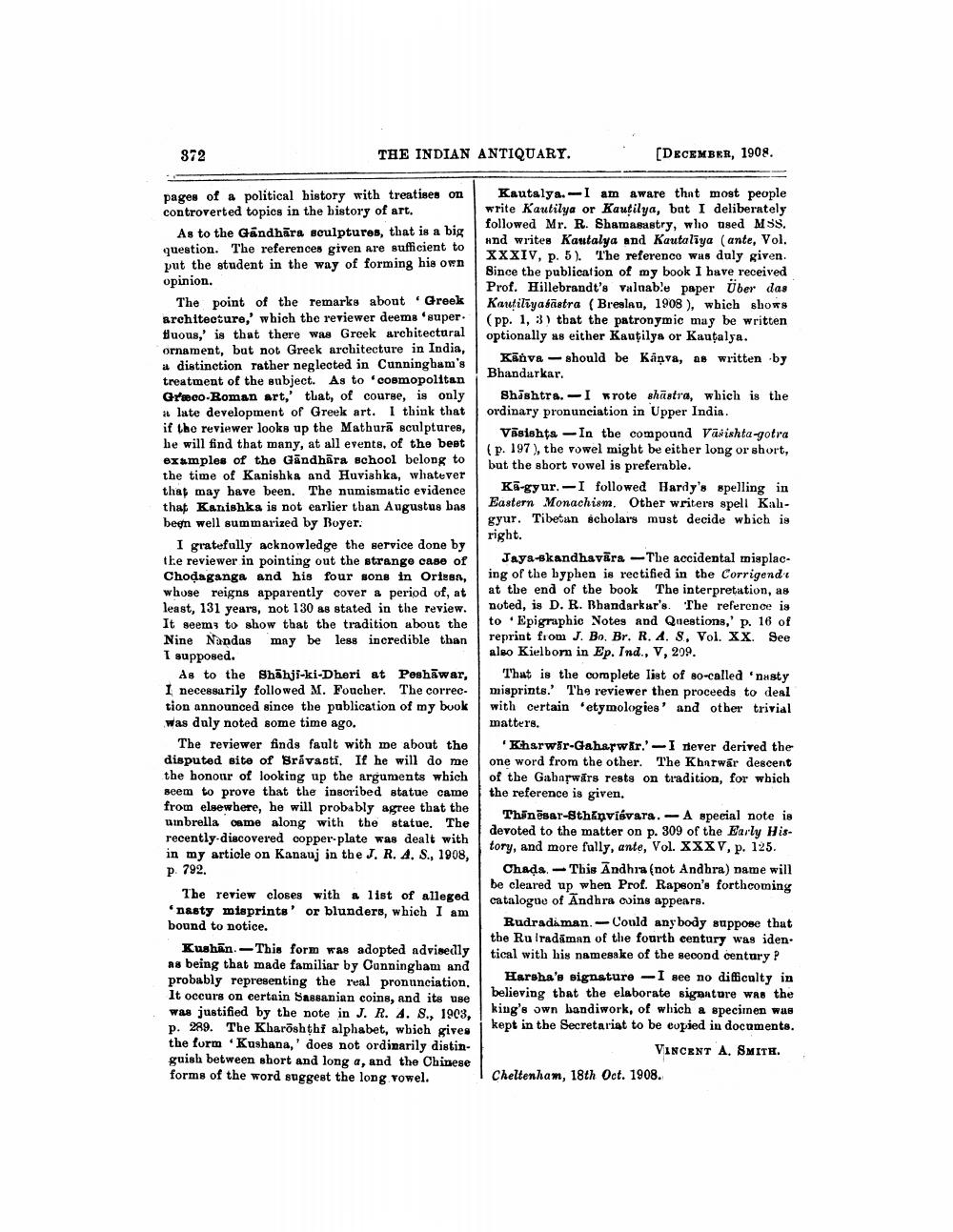________________
872
THE INDIAN ANTIQUARY.
DECEMBER, 1908.
pages of a political history with treatises on Kautalya. -I am aware that most people controverted topics in the bistory of art.
write Kautilya or Kautilya, bat I deliberately
followed Mr. R. Shamasastry, who used MSS. As to the Gāndhāra sculptures, that is a big
and writes Kautalya and Kautalaya (ante, Vol. question. The references given are sufficient to
XXXIV, p. 5). The reference was duly given. put the student in the way of forming his own
Since the publication of my book I have received opinion.
Prof. Hillebrandt's valuable paper Über das The point of the remarks about Greek
Kartilīyadāstra (Breslag, 1908 ), which shows architecture,' which the reviewer deema 'super.
(pp. 1, 3 ) that the patronymic may be written Huous,' is that there was Greek architectural
optionally as either Kautilya or Kautalya. ornament, but not Greek architecture in India,
Kānva - should be Kāņva, as written by a distinction rather neglected in Cunningham's treatment of the subject. As to cosmopolitan
Bhandarkar. Greco-Roman art,' that, of course, is only Shīshtra. - I wrote shastra, which is the alate development of Greek art. I think that ordinary pronunciation in Upper India. if the reviewer looks up the Mathurā sculptures,
Võsishta - In the compound Vasishta-gotra he will find that many, at all events, of the best
(p. 197), the vowel might be either long or short, examples of the Gāndhāra school belong to
but the short vowel is preferable. the time of Kanishka and Huvishka, whatever that may bave been. The numismatic evidence
Kā-gyur. -I followed Hardy's spelling in that Kanishka is not earlier than Augustus bas
Eastern Monachism. Other writers spell Kalbeen well summarized by Boyer.
gyur. Tibetan scholars must decide which is
right. I gratefully acknowledge the service done by the reviewer in pointing out the strange case of
Jaya-skandhavira - The accidental misplacChodaganga and his four sons in Ortsen, ing of the byphen is rectified in the Corrigende whose reigns apparently cover a period of, at at the end of the book The interpretation, as least, 131 years, not 130 as stated in the review.
noted, is D. R. Bhandarkar's. The reference is It seems to show that the tradition about the to . Epigraphic Notes and Questions,' p. 16 of Nine Nandas may be less incredible than reprint from J. Bo, Br. R. 4. S, Vol. XX. See I supposed.
also Kielborn in Ep. Ind., V, 209. As to the Shāhi-ki-Dheri at Peshāwar, That is the complete list of so-called 'nusty I necessarily followed M. Foucher. The correc- misprints. The reviewer then proceeds to deal tion announced since the publication of my book with certain etymologies' and other trivial was duly noted some time ago.
matters. The reviewer finds fault with me about the Kherwir-Gaharwâr.'- I never derived the disputed site of Srávasti. If he will do me | one word from the other. The Khnrwár descent the honour of looking up the arguments which of the Gabarwārs rests on tradition, for which seem to prove that the inscribed statue came the reference is given. from elsewhere, he will probably agree that the
Thinēsar-8thinvisvara. - A special note is umbrella onme along with the statue. The
devoted to the matter on p. 309 of the Early His. recently discovered copper-plate was dealt with in my article on Kanauj in the J. R. A. S., 1908,
tory, and more fully, ante, Vol. XXX V, p. 125. p. 792.
Chada. - This Andhra (not Andhra) name will
be cleared up when Prof. Rapson's forthcoming The review closes with & list of alleged
catalogue of Andhra coins appears. nasty mtaprints' or blunders, which I am bound to notice.
Rudradaman.- Could anybody suppose that
the Ru Iradāman of the fourth century was iden. Kushān. - This form was adopted advisedly tical with his namesake of the second century ? as being that made familiar by Cunningham and probably representing the real pronunciation.
Harsha's signature - I see no difficulty in It occurs on certain Sassanian coins, and its use
believing that the elaborate signature was the was justified by the note in J. R. 4. 8., 1963,
king's own bandiwork, of which a specimen was p. 289. The Kharoshthi alphabet, wbich gives
kept in the Secretariat to be copied in documents. the form .Kushana,' does not ordinarily distin
VINCENT A. SMITH. guish between short and long a, and the Chinese forms of the word suggest the long vowel.
Cheltenham, 18th Oct. 1908.




